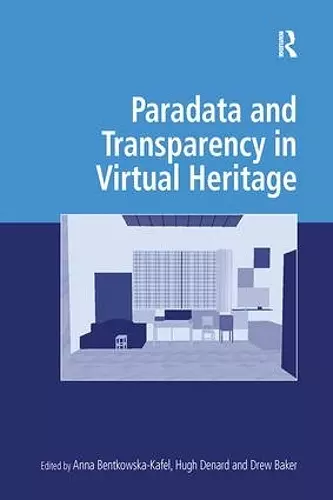Paradata and Transparency in Virtual Heritage
Anna Bentkowska-Kafel editor Hugh Denard editor
Format:Paperback
Publisher:Taylor & Francis Ltd
Published:14th Oct '16
Currently unavailable, and unfortunately no date known when it will be back
This paperback is available in another edition too:
- Hardback£150.00(9780754675839)

Computer-Generated Images (CGIs) are widely used and accepted in the world of entertainment but the use of the very same visualization techniques in academic research in the Arts and Humanities remains controversial. The techniques and conceptual perspectives on heritage visualization are a subject of an ongoing interdisciplinary debate. By demonstrating scholarly excellence and best technical practice in this area, this volume is concerned with the challenge of providing intellectual transparency and accountability in visualization-based historical research. Addressing a range of cognitive and technological challenges, the authors make a strong case for a wider recognition of three-dimensional visualization as a constructive, intellectual process and valid methodology for historical research and its communication. Intellectual transparency of visualization-based research, the pervading theme of this volume, is addressed from different perspectives reflecting the theory and practice of respective disciplines. The contributors - archaeologists, cultural historians, computer scientists and ICT practitioners - emphasize the importance of reliable tools, in particular documenting the process of interpretation of historical material and hypotheses that arise in the course of research. The discussion of this issue refers to all aspects of the intellectual content of visualization and is centred around the concept of 'paradata'. Paradata document interpretative processes so that a degree of reliability of visualization outcomes can be understood. The disadvantages of not providing this kind of intellectual transparency in the communication of historical content may result in visual products that only convey a small percentage of the knowledge that they embody, thus making research findings not susceptible to peer review and rendering them closed to further discussion. It is argued, therefore, that paradata should be recorded alongside more tangible outcomes of research, preferably as an integral part of virtual models, and sustained beyond the life-span of the technology that underpins visualization.
'By addressing a range of conceptual and technological challenges this title demonstrates that providing intellectual accountability, or ’transparency’, is the key to establishing computerised visualisation methods as a rigorous, constructive, and vital contribution to historical research and its communication.' Library and Information Research
ISBN: 9781138245655
Dimensions: unknown
Weight: 453g
344 pages